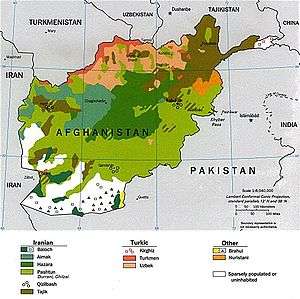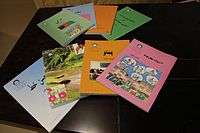Languages of Afghanistan
| Languages of Afghanistan | |
|---|---|
 | |
| Official languages | Dari and Pashto[1] |
| Regional languages | Dari, Pashto, Uzbek, Turkmen, Balochi, Pashayi |
| Sign languages | Afghan Sign Language |
Afghanistan is a multilingual country in which two languages – Dari and Pashto – are both official and most widely spoken.[1] Dari is the official name of the Persian language in Afghanistan. It is often referred to as the Afghan Persian.[2][3] Both Persian and Pashto are Indo-European languages from the Iranian languages sub-family. Other regional languages, such as Uzbek, Turkmen, Balochi, Pashayi and Nuristani are spoken by minority groups across the country.
Minor languages may include Hindi-Urdu,[4][5] Punjabi,[6] Ashkunu, Kamkata-viri, Vasi-vari, Tregami and Kalasha-ala, Pamiri (Shughni, Munji, Ishkashimi and Wakhi), Brahui, Qizilbash, Aimaq, and Pashai and Kyrgyz. Linguist Harald Haarmann believes that Afghanistan is home to more than 40 minor languages,[7] with around 200 different dialects.
Language policy
The official languages of the country are Dari and Pashto; the former is the most spoken language of Afghanistan's official languages and acts as a lingua franca for the country. In 1980, other regional languages were granted official status in the regions where they are the language of the majority,[8] a policy codified in the 2004 Afghan Constitution, which states that Uzbek, Turkmen, Balochi, Pashayi, Nuristani and Pamiri are third official languages in areas where the majority speaks one of these.[1]
Naming policy
Dari is a term long recommended by Afghan authorities to designate the Persian dialects spoken in Afghanistan, in contrast to the dialects spoken in neighboring Iran.[9] Although still widely known as "Farsi" ("Persian") to its native speakers, the name was officially changed to Dari in 1964.[10] Dari must not be confused with the dialect of Kabul, which is the dominant Persian dialect in Afghanistan. Apart from a few basics of vocabulary, however (and more Indo-Persian calligraphic styles in the Perso-Arabic script), there is little difference between formal written Persian of Afghanistan and of Iran. The term Dari is often loosely used for the characteristic spoken Persian of Afghanistan – in general the dialect of Kabul – but is best restricted to formal spoken registers (poetry, speeches, newscasts, and other broadcast announcements).[10]
Overview
Dari functions as the nation's lingua franca and is the native tongue of various Afghan ethnic groups including the Tajiks, Hazaras, and Aimak.[12] Pashto is the native tongue of the Pashtuns, the dominant ethnic group in Afghanistan.[13] Due to Afghanistan's multi-ethnic character, language variety as well as bilingualism and multilingualism are common phenomena.
The exact figures about the size and composition of the various ethnolinguistic groups are unavailable since no systematic census has been held in Afghanistan in decades.[15] Estimates suggest the following primary languages:
According to a 2006 opinion poll survey involving 6,226 randomly selected Afghan citizens by the Asia Foundation, Dari was the first language of 49%, with an additional 37% stating the ability to speak Dari as a second language; 42% were able to read Dari. Second, Pashto was the first language of 40% of the polled people, while an additional 28% spoke it as a second language; 33% were able to read Pashto. Uzbek was the first language of 9% and a second language for 6%. Turkmen was the first language of 2% and a second language for 3%. English was spoken by 8% and Urdu by 7%.[16]
A later study found that Dari was, by a wide margin, the most widely spoken language in urban Afghanistan, with as many as 93% of Afghans claiming to speak it, but only 75% of rural Afghans claiming the same.[17]
A sizeable population in Afghanistan, especially in Kabul, can also speak and understand Hindi-Urdu due to the popularity and influence of Bollywood films and songs in the region.[4][5]
References
- 1 2 3 "What Languages are Spoken in Afghanistan?". 2004. Retrieved June 13, 2012.
Pashto and Dari are the official languages of the state. are – in addition to Pashto and Dari – the third official language in areas where the majority speaks them
- ↑ "Documentation for ISO 639 identifier: prs". Sil.org. 18 January 2010. Retrieved December 5, 2014.
- ↑ "The World Factbook: Afghanistan". Cia.gov. Retrieved December 5, 2014.
- 1 2 Hakala, Walter N. (2012). "Languages as a Key to Understanding Afghanistan's Cultures" (PDF). National Geographic. Retrieved 13 March 2018.
In the 1980s and '90s, at least three million Afghans--mostly Pashtun--fled to Pakistan, where a substantial number spent several years being exposed to Hindi- and Urdu-language media, especially Bollywood films and songs, and beng educated in Urdu-language schools, both of which contributed to the decline of Dari, even among urban Pashtuns.
- 1 2 Krishnamurthy, Rajeshwari (28 June 2013). "Kabul Diary: Discovering the Indian connection". Gateway House: Indian Council on Global Relations. Retrieved 13 March 2018.
Most Afghans in Kabul understand and/or speak Hindi, thanks to the popularity of Indian cinema in the country.
- ↑ Wahab, Shaista; Youngerman, Barry (2007). A Brief History of Afghanistan. Infobase Publishing. p. 18. ISBN 9781438108193.
Afghan Hindus and Sikhs speak Hindi or Punjabi in addition to Dari and Pashto.
- ↑ Harald Haarmann: Sprachen-Almanach – Zahlen und Fakten zu allen Sprachen der Welt. Campus-Verl., Frankfurt/Main 2002, ISBN 3-593-36572-3, S.273–274; Afghanistan
- ↑ "AFGHANISTAN v. Languages". Ch. M. Kieffer. Encyclopædia Iranica. Retrieved 2012-04-08.
A. Official languages. Paṧtō (1) is the native tongue of 50 to 55 percent of Afghans... Persian (2) is the language most spoken in Afghanistan. The native tongue of twenty five percent of the population, it is split into numerous dialects.
- ↑ Ch. M. Kieffer, "AFGHANISTAN v. Languages", Encyclopaedia Iranica, Online Edition, originally from 1982.
- 1 2 R. Farhadi and J. R. Perry, Kaboli, Encyclopaedia Iranica, Online Edition, originally in Vol. XV, Fasc. 3, pp. 276–280, 2009.
- ↑ "South Asia ::AFGHANISTAN". CIA The World Factbook.
- ↑ "Languages of Afghanistan". Encyclopædia Britannica.
- ↑ "Ethnic groups". BBC News. Retrieved 7 June 2013.
Pashtun: Estimated to be in excess of 45% of the population, the Pashtuns have been the most dominant ethnic group in Afghanistan.
- ↑ "Textbooks, Afghan Ministry of Education".
- ↑ O'toole, Pam (October 6, 2004). "Afghan poll's ethnic battleground". BBC News. Retrieved 2010-09-16.
- ↑ "Afghanistan in 2006 - A survey of the Afghan people" (PDF). Kabul, Afghanistan: The Asia Foundation. 2006. Retrieved 2010-10-29.
Uruzgan, representing 1.1 percent of the population of Afghanistan, and Zabul, representing 1.2 percent, were excluded from the sampling plan due to extreme security conditions during the fieldwork period of the survey.
- ↑ "Afghanistan in 2013 - A survey of the Afghan people" (PDF). Kabul, Afghanistan: The Asia Foundation. 2012. Retrieved 2014-03-12.
